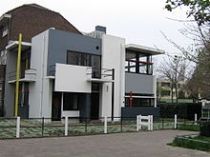The De Stijl movement was a Dutch artistic movement in which artists sought universal laws of balance and harmony for art, which could then be a prototype for a new social order. This movement was unique in that it was a new way of thinking and it was a philosophy that did not only appear in artwork but also in the artists’ every day lives, such as the architecture of their house. Those who were followers of De Stijl tried to keep De Stijl in all aspects of their lives. (Meggs and Purvis)
The Rietveld Schroder House, built according to principles of De Stijl
The main purpose of this movement was to find a new aesthetic of art and principles. De Stijl founders and artists believed that there was a utopian approach to aesthetics through function, line, and specific colors. The movement even had published a magazine between 1917 and 1932 and provided and overview of the movement’s works and theories. In the magazine Piet Mondrian, an important contributor to the movement, commented that the “pure plastic vision should build a new society, in the same way that in art it has built a new plasticism”. Artists of this movement, like Mondrian, strived for reduction of form and simplistic abstraction. (“De Stijl”)
Tableau 2, 1922. Piet Mondrian
De Stijl artists sought an expression of the mathematical structure of the universe and the universal harmony of nature. De Stijl was greatly influenced by M. H. J. Schoenmaekers, a philosophical mathematician. Schoenmaekers related color and lines and stressed the importance of them, “The three principal colors are essentially yellow, blue and red. They are the only colors exists…yellow is the movement of the ray (vertical)…blue is he contrasting color to yellow (horizontal firmament)…red is the mating of yellow and blue”(Wolf). Schoenmaekers believed in the beauty of pure geometry. Geometric forms never change and exist beyond physical reality in what Plato called the “world of ideas”. While De Stijl sought an expression of the harmony of nature, it did not try to imitate nature. Instead, it tried to achieve pure abstraction by reducing everything down to its essential form. Their artwork did not show much personality. They used straight lines and rectangular forms. The color palette was reduced to primary colors, plus black and white. They avoided symmetry and achieved aesthetic balance by the use of opposition.
Composition décentralisée, 1924. Theo Van Doesburg.
De Stijl sought to purify art by banning naturalistic representation, external values, and subjective expression. It turned away from putting emotion into art and focused on the spiritual and intellectual climate of their time. It emerged as an expression of moral recoil from the horrors of World War I. (Jirousek).
I personally do not find this type of art appealing. I think that the structure and strictness of the art is very interesting, but I have a hard time understanding why an artist would want to restrict their art so much. Throughout history, art has swung back and forth between two extremes, complete chaos and complete order. This movement was clearly on the far end of the order side. I found it surprising that this movement was happening around the same time as Expressionism. Expressionism is much closer to the chaos side and is charged with an emotional or spiritual vision. I find expressionism more appealing because I enjoy artwork that has personality and has a clear message.
 Deer in the Woods, 1914. Franz Marc. An example of expressionism.
Deer in the Woods, 1914. Franz Marc. An example of expressionism.
Meggs, Philip B, Alston W. Purvis. Meggs’ History of Graphic Design. Hoboken, N.J: J. Wiley & Sons, 2012. Print.
“De Stijl”. The Museum of Modern Art. 2009. Web. 23 Feb 2014. http://www.moma.org/collection/theme.php?theme_id=10199
Wolf, Justin. “De Stijl Movement, Artists, and Major Works”. The Art Story Foundation. Web. 23 Feb 2014. http://www.theartstory.org/movement-de-stijl.htm
Jirousek, Charlotte. “De Stijl”. 1995. Web. 23 Feb 2014. http://char.txa.cornell.edu/art/decart/destijl/decstijl.htm


